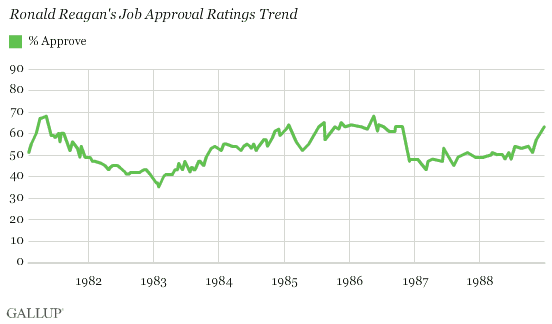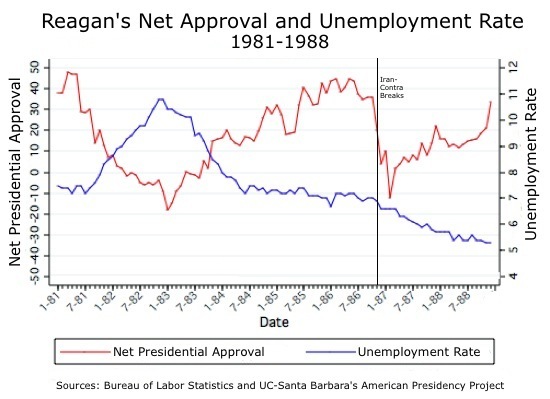The venerable Gallup Poll released its first approval polling numbers for the Obama presidency yesterday. As most of you know, since FDR’s presidency Gallup has been asking a random sample of the American public “Do you approve or disapprove of the way [president’s name] is handling his job as president?” (Gallup actually began presidential approval polling in the 1930’s, but didn’t settle on this wording until FDR’s third term and didn’t begin regular monthly polling until the start of Truman’s presidency in 1945).
According to Gallup, 68% of Americans surveyed from Jan. 21-23, 2009 approved of the job Obama was doing, while only 12% disapproved, with another 21% expressing no opinion. Over the course of Obama’s presidency, versions of this question will be asked by news organizations on an almost weekly basis, and the results will be mistakenly trumpeted by the news media and the punditocracy as a useful barometer of how well Obama is doing his job. Given the ubiquity of approval polling, I thought it worthwhile to put these initial results in their historical context, as a first step in understanding the sources of a president’s popularity and how those numbers are driven by influences that have little to do with a president’s job performance.
.
Because only Gallup has polling data going back to FDR, I will focus on the Gallup data.
Here are the initial approval figures for the 9 presidents first elected to office in the post-FDR “modern” presidential era. How does Obama’s approval rating compare?
|
Year
|
Dates
|
President
|
Approval %
|
Disapproval %
|
No Opinion
|
|
1953
|
Feb. 1-5
|
Eisenhower
|
68
|
7
|
25
|
|
1961
|
Feb. 10-15
|
Kennedy
|
72
|
6
|
22
|
|
1969
|
Jan. 23-28
|
Nixon
|
59
|
5
|
36
|
|
1977
|
Feb. 4-7
|
Carter
|
66
|
8
|
26
|
|
1981
|
Jan. 30- Feb. 2
|
Reagan
|
51
|
13
|
36
|
|
1989
|
Jan. 24-26
|
Bush
|
51
|
6
|
43
|
|
1993
|
Jan. 24-26
|
Clinton
|
58
|
20
|
22
|
|
2001
|
Feb. 1-4
|
Bush II
|
57
|
25
|
18
|
|
2009
|
Jan. 21-23
|
Obama
|
68
|
12
|
21
|
To begin, Obama’s first rating is tied with Eisenhower for the second highest initial approval, and is about 7% above the average of 61.1% approval for this cohort. Kennedy’s rating of 72% is the highest. It’s no coincidence, I think, that Obama and JFK have the two highest initial approval ratings – both are presidents whose elections broke longstanding barriers to the nation’s highest office.
Interestingly, however, Obama’s disapproval is no lower than the average of 11.1%, and, in fact, 5 of the 9 presidents had lower DISapproval ratings than Obama’s. The percentage of respondents with no opinion of Obama’s performance is almost 7% lower than the average of 27.7%. Only 1 president entered office with fewer people having no opinion of his performance: Obama’s predecessor George W. Bush.
We see then, that Obama takes office with fully 79% of Americans already willing to express an opinion of his performance, three days into the job. This is the second highest proportion ever recorded this early in a presidency. It reflects, I think, the ever escalating media coverage of the presidential selection process and the transition period. In this era of 24-7 news coverage, augmented by a highly partisan blogosphere, Americans have more information by which to make an initial judgment of the president’s performance. That Obama starts office with a historically high level of support bodes well for his presidency, particularly given the high number of people who are willing to express an opinion. On the other hand, we also see that he is, comparatively speaking, already a somewhat polarizing figure, much like his two predecessors were at this stage of their presidencies.
Note, however, that these initial judgments are still highly malleable. Obama is currently experiencing the presidential “honeymoon” – an initial period of inflated support for the new president that can last for several months before it begins inevitably to dissipate. Given the historic nature of his election, we ought not to be surprised that his initial approval is so high. And this should remind us that approval ratings are driven by factors that have little to do with the president’s actions in office.
Given this high level of support, why do I predict that it will dissipate? Note that Obama won slightly less than 53% of the popular vote. As of now, then, he’s attracting support of roughly 15% of Americans who are not “naturally” inclined to support him. This is what we mean by a presidential honeymoon period; during this initial phase of the presidency, we project our highest hopes on the president. With no evidence to the contrary, we believe that he will fulfill all our expectations. (He will close Gitmo! He will restore American respect abroad and protect civil liberties at home! I know he’ll have combat troops out of Iraq in 16 months!) For those of you who are married, think back to your honeymoon. When did it dawn on you that your spouse might be less than perfect? How soon before you noted how (s)he squeezed the toothpaste tube from the middle and left the toilet seat up/down? So it is, inevitably, with presidents – the reality of the marriage can’t possibly live up to the unrealistic expectations nurtured during the honeymoon. At some point, we will catch him in the political equivalent of passing wind at the dinner table, and the bloom will be off the rose.
There is a second problem with the honeymoon beyond the inevitable disillusionment. Because of these high honeymoon-induced approval ratings, and the media’s tendency to use the first 100 days as an initial measuring rod to gauge presidential success, presidents often feel pressured in this span to move quickly to pass their major legislative initiatives through Congress. That impulse, and the use of the 100 Days yardstick, I will argue in a later post, is a mistake. In 1993 it caused no little grief for the Clinton presidency when they promised to produce legislation for health care reform within the first 100 Days of their presidency, only to completely miss the deadline. It was the first sign that health care reform would not go well. Obama ought to downplay the 100 Day measuring rod at all costs .
More generally, we can expect Obama’s honeymoon to last 3 to 6 months, during which he may actually gain up to 5% in approval support before that number begins to erode. Indeed, if we pool prior presidencies to produce a “generic” presidential approval trend and use that to predict how Obama’s approval plays out, we would expect the following: his approval rating will remain high, in the 60% range, for at least the next three months or so, at which point it will begin eroding at a relatively constant rate through his first term. Note that this rate of decline will mirror George W. Bush’s loss of support after 9-11, although Bush started from a higher approval point due to the rally round the flag impact of the terrorist strike. Expect Obama to lose between 10 to 20% approval support in his first two years in office. Somewhere in Obama’s 3rd year he will shift to reelection mode, at which point his approval will begin to climb a bit until the 2012 presidential election.
All this assumes, of course, that Obama’s support mimics in its broad outline the approval trends of previous presidents. But why would this be the case? Isn’t each presidency unique, with its own approval dynamics? Although there are unique (and unpredictable) aspects to each presidency – see 9-11! – there are also surprising similarities in opinion dynamics across presidencies. These similarities reflect systemic variables that affect all presidencies. In later posts, I’ll take you through the intricacies of presidential polling to see if we can understand the source of these numbers, and why all presidents almost without exception become less popular over time. I’ll also explain why the news media almost always misinterprets these numbers.
For now, however, Obama should enjoy the honeymoon. It won’t last forever. And leave that toilet seat down!



